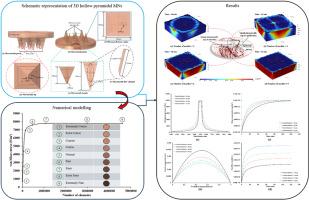Incorporating fluid-structure interactions for modelling of pyramidal hollow microneedles for transdermal drug delivery
IF 4.9
3区 医学
Q1 PHARMACOLOGY & PHARMACY
Journal of Drug Delivery Science and Technology
Pub Date : 2025-09-22
DOI:10.1016/j.jddst.2025.107561
引用次数: 0
Abstract
Hollow microneedles (HMNs) have gained significant attention as a potential alternative to traditional hypodermic needles for delivering drugs through the skin. The rational selection of the HMN geometry and materials is essential for balancing the MN's mechanical stability and efficient drug delivery. In addressing this, the current study aims to develop a numerical model for fluid-structure interactions (FSI) in hollow pyramidal-shaped MNs where HMNs made from two polymers (polylactic acid (PLA) and polyglycolic acid (PGA)) and one metal (stainless steel (SS)) are considered. Finite element (FE) simulations have been performed with COMSOL 6.2 Multiphysics to determine the effect of MN design parameters such as wall thickness, pitch, channel diameter, and dual-zone MN structure (different MN lengths) on fluid flow and von Mises stress distribution in the HMNs. The FSI analysis has been conducted for a laminar flow of water-fentanyl mixture as a model fluid. The findings revealed that raising the inlet pressure from 10 kPa to 30 kPa at the HMN entrance increases the flow rate to 0.005 μl/s, velocity 0.003 m/s, and total drug flux by 248.63 %. As expected, SS demonstrated the lowest von Mises stress (13 213 N/m2) while PLA and PGA exhibited a decrease in the stress level as the HMN wall thickness increased. Increasing the MN pitch from 400 μm to 1200 μm reduced skin pore pressure by 72 % and enhanced drug concentration by 11.4 %. The dual-zone MN arrangement, combining shorter and longer needles, improved the HMN penetration and led to a 90.8 % increase in overall flux. These findings provide a foundation for optimising HMN designs, ensuring a balance between mechanical stability and improved transdermal drug diffusion for clinical applications.

经皮给药锥体空心微针的流固耦合建模
空心微针(HMNs)作为一种潜在的替代传统皮下注射针头通过皮肤给药的方法已经引起了人们的极大关注。合理的选择几何形状和材料是平衡MN的机械稳定性和有效给药的必要条件。为了解决这个问题,目前的研究旨在开发一个空心金字塔形网状结构中流固相互作用(FSI)的数值模型,其中由两种聚合物(聚乳酸(PLA)和聚乙醇酸(PGA))和一种金属(不锈钢(SS))制成的网状结构。利用COMSOL 6.2 Multiphysics进行了有限元模拟,以确定MN设计参数(如壁厚、节距、沟道直径和双区MN结构(不同MN长度))对MN中流体流动和von Mises应力分布的影响。以水-芬太尼混合物层流为模型流体,进行了FSI分析。结果表明:将HMN入口压力从10 kPa提高到30 kPa,流速提高到0.005 μl/s,流速提高到0.003 m/s,总药流量提高了248.63%;正如预期的那样,SS的von Mises应力最低(13 213 N/m2),而PLA和PGA的应力水平随着HMN壁厚的增加而降低。将MN间距从400 μm增加到1200 μm,皮肤孔隙压力降低72%,药物浓度提高11.4%。双区MN排列,结合短针和长针,提高了HMN的穿透性,使总通量提高了90.8%。这些发现为优化HMN设计提供了基础,确保了临床应用中机械稳定性和改善透皮药物扩散之间的平衡。
本文章由计算机程序翻译,如有差异,请以英文原文为准。
求助全文
约1分钟内获得全文
求助全文
来源期刊
CiteScore
8.00
自引率
8.00%
发文量
879
审稿时长
94 days
期刊介绍:
The Journal of Drug Delivery Science and Technology is an international journal devoted to drug delivery and pharmaceutical technology. The journal covers all innovative aspects of all pharmaceutical dosage forms and the most advanced research on controlled release, bioavailability and drug absorption, nanomedicines, gene delivery, tissue engineering, etc. Hot topics, related to manufacturing processes and quality control, are also welcomed.

 求助内容:
求助内容: 应助结果提醒方式:
应助结果提醒方式:


